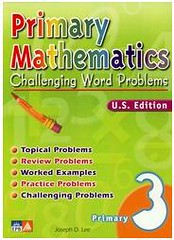
I love the way Singapore math approaches word problems. I use it for all my students including tutoring college students.
When I teach word problems to my math booster classes, I teach them the Singapore math model of all parts add to a whole. So you draw a rectangle to represent the whole. You draw a rectangle of exactly the same size below the first one but break it into the number of parts listed in the problem. If you are given all the parts in the problem, you add them to get the whole. If you are given the whole, then you will either be given all but one part or you will be given the relationship between the parts.
For example:
Your mom bought 6 apples and 8 pears. How many pieces of fruit did she buy? This gives 2 parts that you add to get the total.
You mom bought 14 apples and pears. She bought 6 apples. How many pears did she buy? This is the same problem, but you are given the total and one part and you have to subtract to get the second part.
Now, in Singapore math, the complexity increases when you are given a total and the relationship between parts.
Your mom buys 14 apples and pears. She buy 2 more apples than pears. How many apples did she buy. You are give a total and the relationship between the two parts. The beauty of the Singapore math system is that the rectangles that you draw, one on top of another, show that you take 2 away from 14 and divide 12 by 2 to get the number of pears and add two to get the number of apples.
'Classic' problems in algebra like the ones you describe (coin, mixture, rate) are done exactly the same way except that you must also practice dimensional analysis. The numbers in the problem are not necessarily directly additive.
For example, a 'classic' rate problem is this: two trains depart from different cities heading towards each other. One is going 55mph and one is going 65mph. If the cities are 330 miles apart, how long will it take them to pass each other?
This is still a word problem with two parts adding to one total. But the total is in miles and the parts are given as a rate. Rates are not additive, so the rates must be converted into miles and the miles from the two different trains have to add to 330. The relationship between the two parts is given by time since when they pass each other, each has been traveling the same amount of time. So 55t+65t=330. Solve for t.
What this shows is that by the time Singapore students get to algebra, they already have a method to solve all the word problems. All they have to do is substitute a letter for one of the boxes.
Cool!
Thanks!
Of course this motivates me to drag Christopher by the hair back to the Challenging Word Problems book.
No comments:
Post a Comment